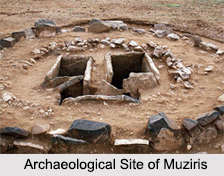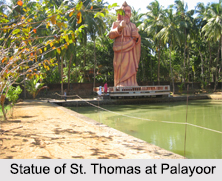 Early History of Thissur District is closely interlinked with trade with Greece, Italy, Rome and Germany. The early political history of Thrissur is interlinked with that of the Chera Dynasty of the Sangam age, who ruled over vast portions of Kerala with their capital at Vanchi. Kodungallur was also the capital of Cheraman Perumal, the last Chera ruler in the 7th century.
Early History of Thissur District is closely interlinked with trade with Greece, Italy, Rome and Germany. The early political history of Thrissur is interlinked with that of the Chera Dynasty of the Sangam age, who ruled over vast portions of Kerala with their capital at Vanchi. Kodungallur was also the capital of Cheraman Perumal, the last Chera ruler in the 7th century.
Chera Dynasty in Thisur
During the time of the Chera ruler, Kodungallur was an important trade link in Indian Ancient Maritime History. The whole of the present Thrissur district was included in the early Chera Empire. The district can claim to have played a significant part in fostering the trade relations between Kerala and outside world in the ancient and medieval period. It can also claim to have played an important part in fostering cultural relations and in laying the foundation of a cosmopolitan and composite culture in this part of the country. Muziris (Muchiri) was an important port city in the pre-historic era.
Muziris Port in Thissur
Muziris is a lost port city in Kodungallur and was a major center of trade in Kerala between the Chera Empire and the Roman Empire. Muziris was destroyed by massive flooding of the river Periyar in 1341, opening a new port called Kochi. Muziris was also known as Mahodayapuram, Shinkli, Muchiri and Muyirikkodu. It is known as `Vanchi` to locals.
Importance of Muziris in Early Age
 Muziris was opened for Arabs, Romans, Portuguese, Dutch and English to Indian sub continent and South East Asia. Muziris dealers had set Indo-Greek and Indo-Roman trade with Egypt, which comes in gold and other metals, pepper and spices, precious stones and textiles. It was famous as a major port for trade and commerce for more than 2,500 years. Muziris became an interest to classical authors because of the Romans` interest in trading, and their desire to have contact with regions beyond the reach of easy conquest so they had set up trading routes with these places. The merchants from a number of cultures are believed to have operated in the port, and there are numerous Indian finds from the time as well as Roman ones.
Muziris was opened for Arabs, Romans, Portuguese, Dutch and English to Indian sub continent and South East Asia. Muziris dealers had set Indo-Greek and Indo-Roman trade with Egypt, which comes in gold and other metals, pepper and spices, precious stones and textiles. It was famous as a major port for trade and commerce for more than 2,500 years. Muziris became an interest to classical authors because of the Romans` interest in trading, and their desire to have contact with regions beyond the reach of easy conquest so they had set up trading routes with these places. The merchants from a number of cultures are believed to have operated in the port, and there are numerous Indian finds from the time as well as Roman ones.
St Thomas in Thissur
During 52 AD, St Thomas landed at Palayoor by boat from Muziris. He came to visit the Jewish merchants at Palayur Judankunnu and to preach the good news in course of time.
The indigenous church of Kerala has a tradition that St. Thomas sailed there to spread the Christian faith. He landed at the ancient port of Muziris. He then went to Palayoor (near present-day Guruvayoor), which was a Hindu priestly community at that time. He left Palayoor for the southern part of Kerala, where he established the Ezharappallikal, or "Seven and Half Churches". These churches are at Kodungallur, Kollam, Niranam, Nilackal (Chayal), Kokkamangalam, Kottakkavu, Palayoor (Chattukulangara) and Thiruvithancode Arappally - the half church.
Cheraman Juma Masjid in Early Era
It was believed that Cheraman Juma Masjid was built in 629 AD by Malik Bin Deenar. Cheraman Juma Masjid is considered as the oldest mosque in India and the second oldest mosque in the world to offer Jumu`ah prayers. It was constructed during the lifetime of Muhammad, the bodies of some of his original followers are said to be buried here. Unlike other mosques in Kerala that face westwards, this mosque faces eastwards.



















